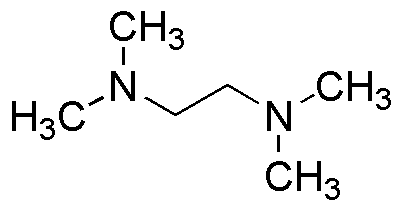N,N,N'N'-Tetramethylethylenediamine is widely utilized in research focused on:
- Polymer Chemistry: It serves as a catalyst in the production of polyurethanes, enhancing the speed and efficiency of the polymerization process, which is crucial for manufacturing durable materials.
- Organic Synthesis: This compound is used as a reagent in various organic reactions, facilitating the formation of complex molecules, which is essential in pharmaceuticals and agrochemicals.
- Electrochemistry: It acts as a stabilizing agent in the formulation of electrolytes for batteries, improving performance and longevity, which is vital for energy storage solutions.
- Analytical Chemistry: N,N,N'N'-Tetramethylethylenediamine is employed in chromatography as a derivatizing agent, aiding in the separation and identification of compounds, thus enhancing analytical accuracy.
- Biotechnology: It is utilized in cell culture media to promote cell growth and viability, supporting research in cellular biology and regenerative medicine.
General Information
Properties
Safety and Regulations
Applications
N,N,N'N'-Tetramethylethylenediamine is widely utilized in research focused on:
- Polymer Chemistry: It serves as a catalyst in the production of polyurethanes, enhancing the speed and efficiency of the polymerization process, which is crucial for manufacturing durable materials.
- Organic Synthesis: This compound is used as a reagent in various organic reactions, facilitating the formation of complex molecules, which is essential in pharmaceuticals and agrochemicals.
- Electrochemistry: It acts as a stabilizing agent in the formulation of electrolytes for batteries, improving performance and longevity, which is vital for energy storage solutions.
- Analytical Chemistry: N,N,N'N'-Tetramethylethylenediamine is employed in chromatography as a derivatizing agent, aiding in the separation and identification of compounds, thus enhancing analytical accuracy.
- Biotechnology: It is utilized in cell culture media to promote cell growth and viability, supporting research in cellular biology and regenerative medicine.
Documents
Safety Data Sheets (SDS)
The SDS provides comprehensive safety information on handling, storage, and disposal of the product.
Product Specification (PS)
The PS provides a comprehensive breakdown of the product’s properties, including chemical composition, physical state, purity, and storage requirements. It also details acceptable quality ranges and the product's intended applications.
Certificates of Analysis (COA)
Search for Certificates of Analysis (COA) by entering the products Lot Number. Lot and Batch Numbers can be found on a product’s label following the words ‘Lot’ or ‘Batch’.
*Catalog Number
*Lot Number
Certificates Of Origin (COO)
This COO confirms the country where the product was manufactured, and also details the materials and components used in it and whether it is derived from natural, synthetic, or other specific sources. This certificate may be required for customs, trade, and regulatory compliance.
*Catalog Number
*Lot Number
Safety Data Sheets (SDS)
The SDS provides comprehensive safety information on handling, storage, and disposal of the product.
DownloadProduct Specification (PS)
The PS provides a comprehensive breakdown of the product’s properties, including chemical composition, physical state, purity, and storage requirements. It also details acceptable quality ranges and the product's intended applications.
DownloadCertificates of Analysis (COA)
Search for Certificates of Analysis (COA) by entering the products Lot Number. Lot and Batch Numbers can be found on a product’s label following the words ‘Lot’ or ‘Batch’.
*Catalog Number
*Lot Number
Certificates Of Origin (COO)
This COO confirms the country where the product was manufactured, and also details the materials and components used in it and whether it is derived from natural, synthetic, or other specific sources. This certificate may be required for customs, trade, and regulatory compliance.


